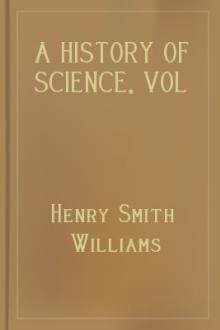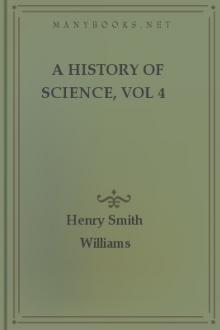A History of Science, vol 1, Henry Smith Williams [read out loud books TXT] 📗

- Author: Henry Smith Williams
- Performer: -
Book online «A History of Science, vol 1, Henry Smith Williams [read out loud books TXT] 📗». Author Henry Smith Williams
Although the functions of the organs in the chest were not well understood by Galen, he was well acquainted with their anatomy.
He knew that the lungs were covered by thin membrane, and that the heart was surrounded by a sac of very similar tissue. He made constant comparisons also between these organs in different animals, as his dissections were performed upon beasts ranging in size from a mouse to an elephant. The minuteness of his observations is shown by the fact that he had noted and described the ring of bone found in the hearts of certain animals, such as the horse, although not found in the human heart or in most animals.
His description of the abdominal organs was in general accurate.
He had noted that the abdominal cavity was lined with a peculiar saclike membrane, the peritoneum, which also surrounded most of the organs contained in the cavity, and he made special note that this membrane also enveloped the liver in a peculiar manner. The exactness of the last observation seems the more wonderful when we reflect that even to-day the medical, student finds a correct understanding of the position of the folds of the peritoneum one of the most difficult subjects in anatomy.
As a practical physician he was held in the highest esteem by the Romans. The Emperor Marcus Aurelius called him to Rome and appointed him physician-inordinary to his son Commodus, and on special occasions Marcus Aurelius himself called in Galen as his medical adviser. On one occasion, the three army surgeons in attendance upon the emperor declared that he was about to be attacked by a fever. Galen relates how “on special command I felt his pulse, and finding it quite normal, considering his age and the time of day, I declared it was no fever but a digestive disorder, due to the food he had eaten, which must be converted into phlegm before being excreted. Then the emperor repeated three times, ‘That’s the very thing,’ and asked what was to be done. I answered that I usually gave a glass of wine with pepper sprinkled on it, but for you kings we only use the safest remedies, and it will suffice to apply wool soaked in hot nard ointment locally. The emperor ordered the wool, wine, etc., to be brought, and I left the room. His feet were warmed by rubbing with hot hands, and after drinking the peppered wine, he said to Pitholaus (his son’s tutor), ‘We have only one doctor, and that an honest one,’ and went on to describe me as the first of physicians and the only philosopher, for he had tried many before who were not only lovers of money, but also contentious, ambitious, envious, and malignant.”[7]
It will be seen from this that Galen had a full appreciation of his own abilities as a physician, but inasmuch as succeeding generations for a thousand years concurred in the alleged statement made by Marcus Aurelius as to his ability, he is perhaps excusable for his open avowal of his belief in his powers. His faith in his accuracy in diagnosis and prognosis was shown when a colleague once said to him, “I have used the prognostics of Hippocrates as well as you. Why can I not prognosticate as well as you?” To this Galen replied, “By God’s help I have never been deceived in my prognosis.”[8] It is probable that this statement was made in the heat of argument, and it is hardly to be supposed that he meant it literally.
His systems of treatment were far in advance of his theories regarding the functions of organs, causes of disease, etc., and some of them are still first principles with physicians. Like Hippocrates, he laid great stress on correct diet, exercise, and reliance upon nature. “Nature is the overseer by whom health is supplied to the sick,” he says. “Nature lends her aid on all sides, she decides and cures diseases. No one can be saved unless nature conquers the disease, and no one dies unless nature succumbs.”
From the picture thus drawn of Galen as an anatomist and physician, one might infer that he should rank very high as a scientific exponent of medicine, even in comparison with modern physicians. There is, however, another side to the picture. His knowledge of anatomy was certainly very considerable, but many of his deductions and theories as to the functions of organs, the cause of diseases, and his methods of treating them, would be recognized as absurd by a modern school-boy of average intelligence. His greatness must be judged in comparison with ancient, not with modern, scientists. He maintained, for example, that respiration and the pulse-beat were for one and the same purpose—that of the reception of air into the arteries of the body. To him the act of breathing was for the purpose of admitting air into the lungs, whence it found its way into the heart, and from there was distributed throughout the body by means of the arteries. The skin also played an important part in supplying the body with air, the pores absorbing the air and distributing it through the arteries. But, as we know that he was aware of the fact that the arteries also contained blood, he must have believed that these vessels contained a mixture of the two.
Modern anatomists know that the heart is divided into two approximately equal parts by an impermeable septum of tough fibres. Yet, Galen, who dissected the hearts of a vast number of the lower animals according to his own account, maintained that this septum was permeable, and that the air, entering one side of the heart from the lungs, passed through it into the opposite side and was then transferred to the arteries.
He was equally at fault, although perhaps more excusably so, in his explanation of the action of the nerves. He had rightly pointed out that nerves were merely connections between the brain and spinal-cord and distant muscles and organs, and had recognized that there were two kinds of nerves, but his explanation of the action of these nerves was that “nervous spirits” were carried to the cavities of the brain by blood-vessels, and from there transmitted through the body along the nerve-trunks.
In the human skull, overlying the nasal cavity, there are two thin plates of bone perforated with numerous small apertures.
These apertures allow the passage of numerous nerve-filaments which extend from a group of cells in the brain to the delicate membranes in the nasal cavity. These perforations in the bone, therefore, are simply to allow the passage of the nerves. But Galen gave a very different explanation. He believed that impure “animal spirits” were carried to the cavities of the brain by the arteries in the neck and from there were sifted out through these perforated bones, and so expelled from the body.
He had observed that the skin played an important part in cooling the body, but he seems to have believed that the heart was equally active in overheating it. The skin, therefore, absorbed air for the purpose of “cooling the heart,” and this cooling process was aided by the brain, whose secretions aided also in the cooling process. The heart itself was the seat of courage; the brain the seat of the rational soul; and the liver the seat of love.
The greatness of Galen’s teachings lay in his knowledge of anatomy of the organs; his weakness was in his interpretations of their functions. Unfortunately, succeeding generations of physicians for something like a thousand years rejected the former but clung to the latter, so that the advances he had made were completely overshadowed by the mistakes of his teachings.
XI. A RETROSPECTIVE GLANCE AT CLASSICAL SCIENCE
It is a favorite tenet of the modern historian that history is a continuous stream. The contention has fullest warrant. Sharp lines of demarcation are an evidence of man’s analytical propensity rather than the work of nature. Nevertheless it would be absurd to deny that the stream of history presents an ever-varying current. There are times when it seems to rush rapidly on; times when it spreads out into a broad—seemingly static—current; times when its catastrophic changes remind us of nothing but a gigantic cataract. Rapids and whirlpools, broad estuaries and tumultuous cataracts are indeed part of the same stream, but they are parts that vary one from another in their salient features in such a way as to force the mind to classify them as things apart and give them individual names.
So it is with the stream of history; however strongly we insist on its continuity we are none the less forced to recognize its periodicity. It may not be desirable to fix on specific dates as turning-points to the extent that our predecessors were wont to do. We may not, for example, be disposed to admit that the Roman Empire came to any such cataclysmic finish as the year 476 A.D., when cited in connection with the overthrow of the last Roman Empire of the West, might seem to indicate. But, on the other hand, no student of the period can fail to realize that a great change came over the aspect of the historical stream towards the close of the Roman epoch.
The span from Thales to Galen has compassed about eight hundred years—let us say thirty generations. Throughout this period there is scarcely a generation that has not produced great scientific thinkers—men who have put their mark upon the progress of civilization; but we shall see, as we look forward for a corresponding period, that the ensuing thirty generations produced scarcely a single scientific thinker of the first rank.
Eight hundred years of intellectual activity —thirty generations of greatness; then eight hundred years of stasis—thirty generations of mediocrity; such seems to be the record as viewed in perspective. Doubtless it seemed far different to the contemporary observer; it is only in reasonable perspective that any scene can be viewed fairly. But for us, looking back without prejudice across the stage of years, it seems indisputable that a great epoch came to a close at about the time when the barbarian nations of Europe began to sweep down into Greece and Italy. We are forced to feel that we have reached the limits of progress of what historians are pleased to call the ancient world. For about eight hundred years Greek thought has been dominant, but in the ensuing period it is to play a quite subordinate part, except in so far as it influences the thought of an alien race. As we leave this classical epoch, then, we may well recapitulate in brief its triumphs. A few words will suffice to summarize a story the details of which have made up our recent chapters.
In the field of cosmology, Greek genius has demonstrated that the earth is spheroidal, that the moon is





Comments (0)